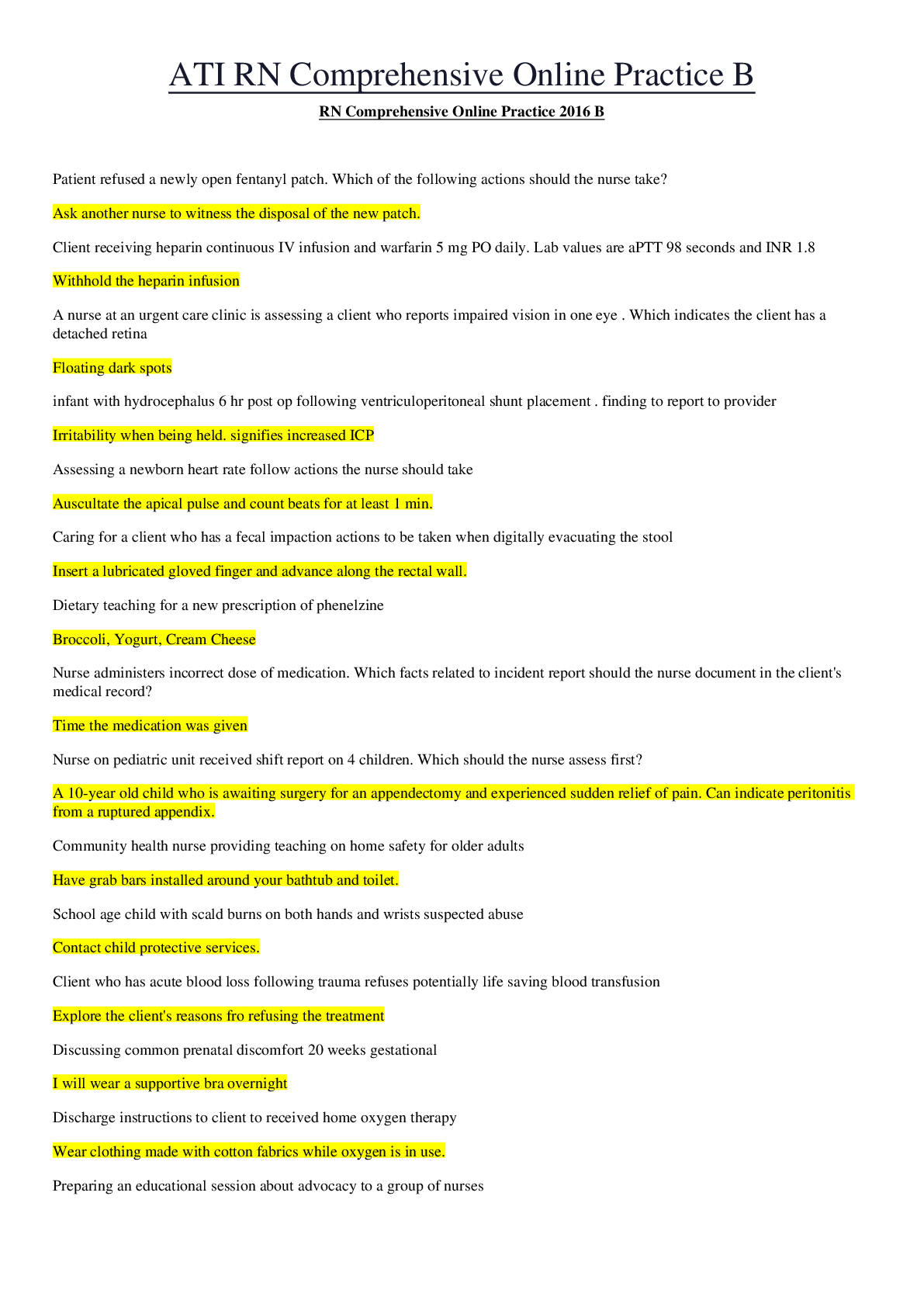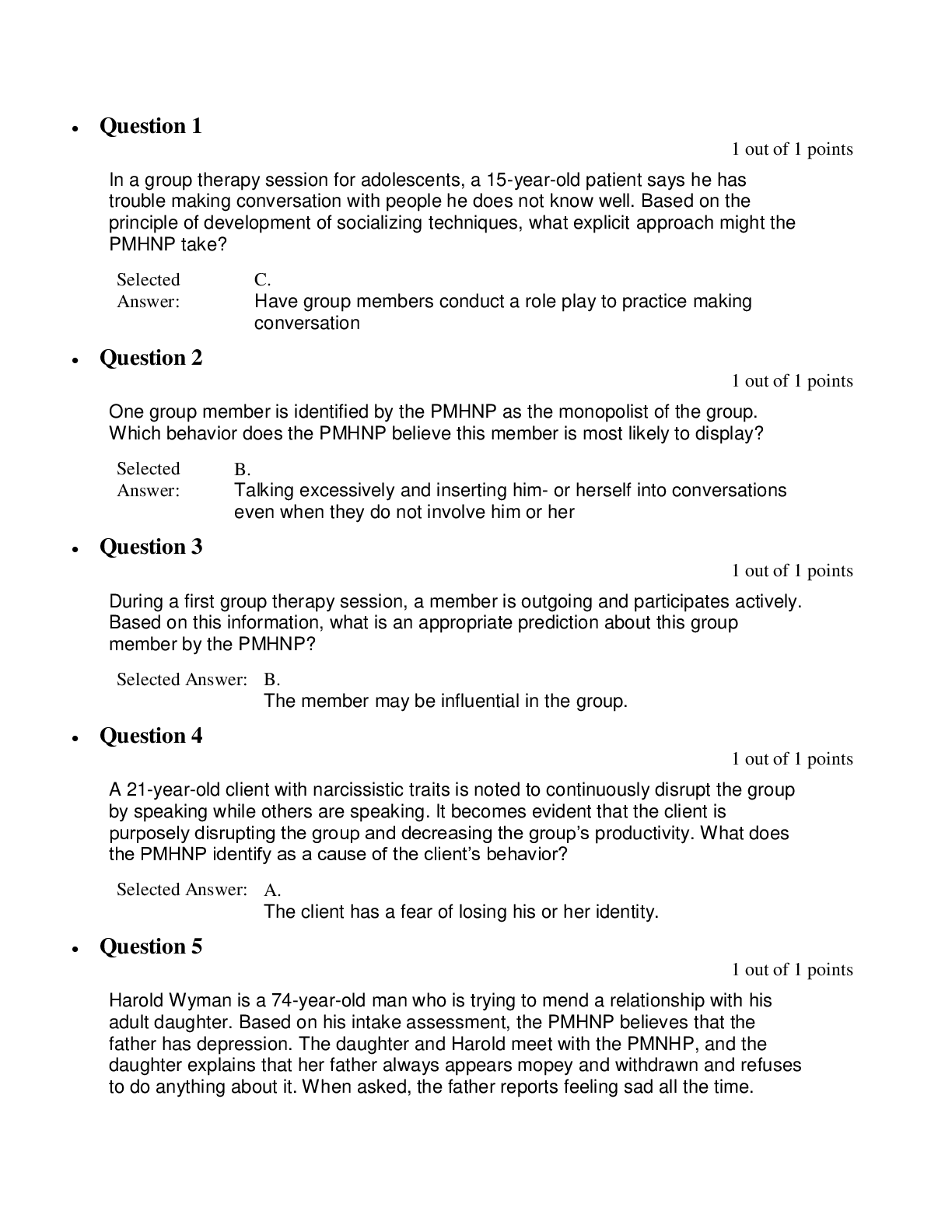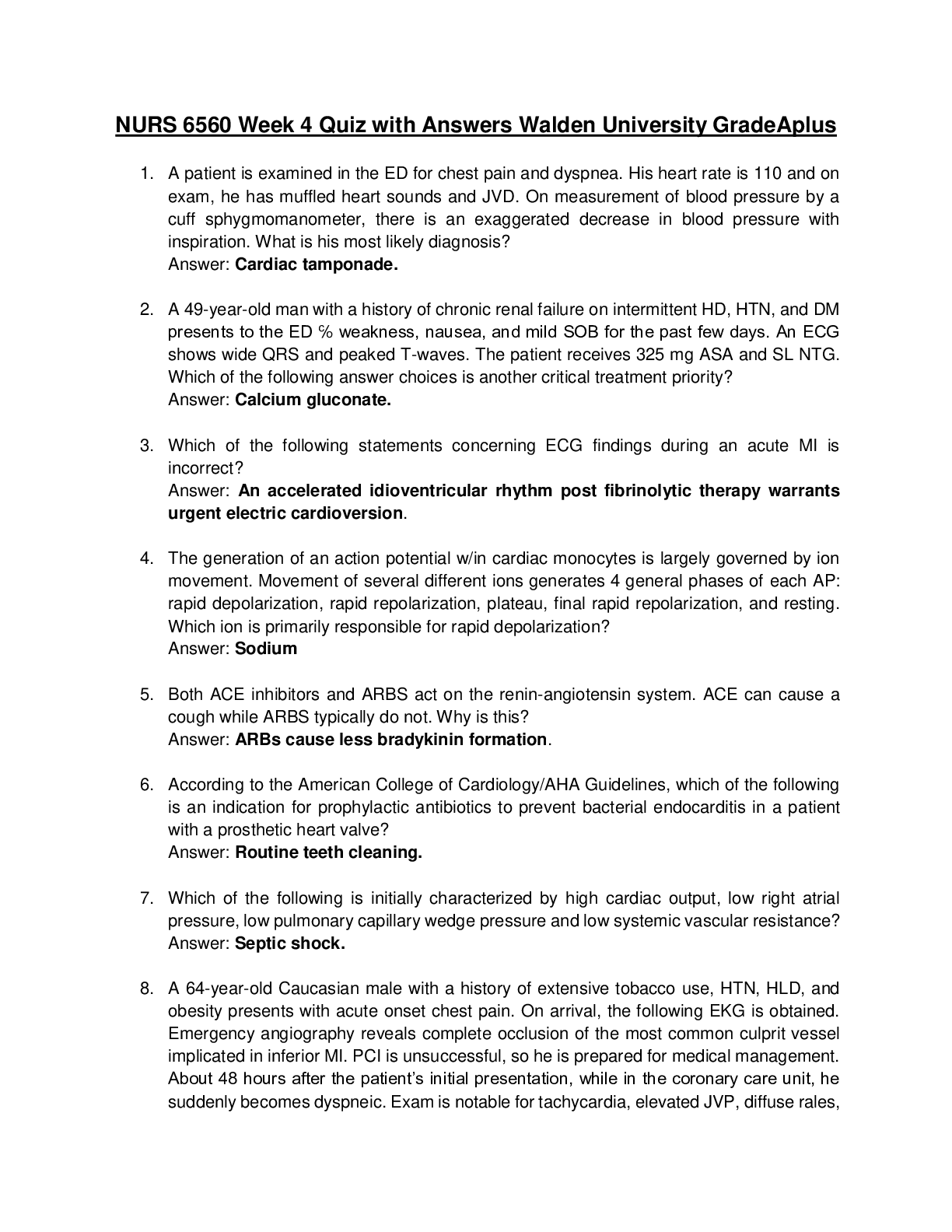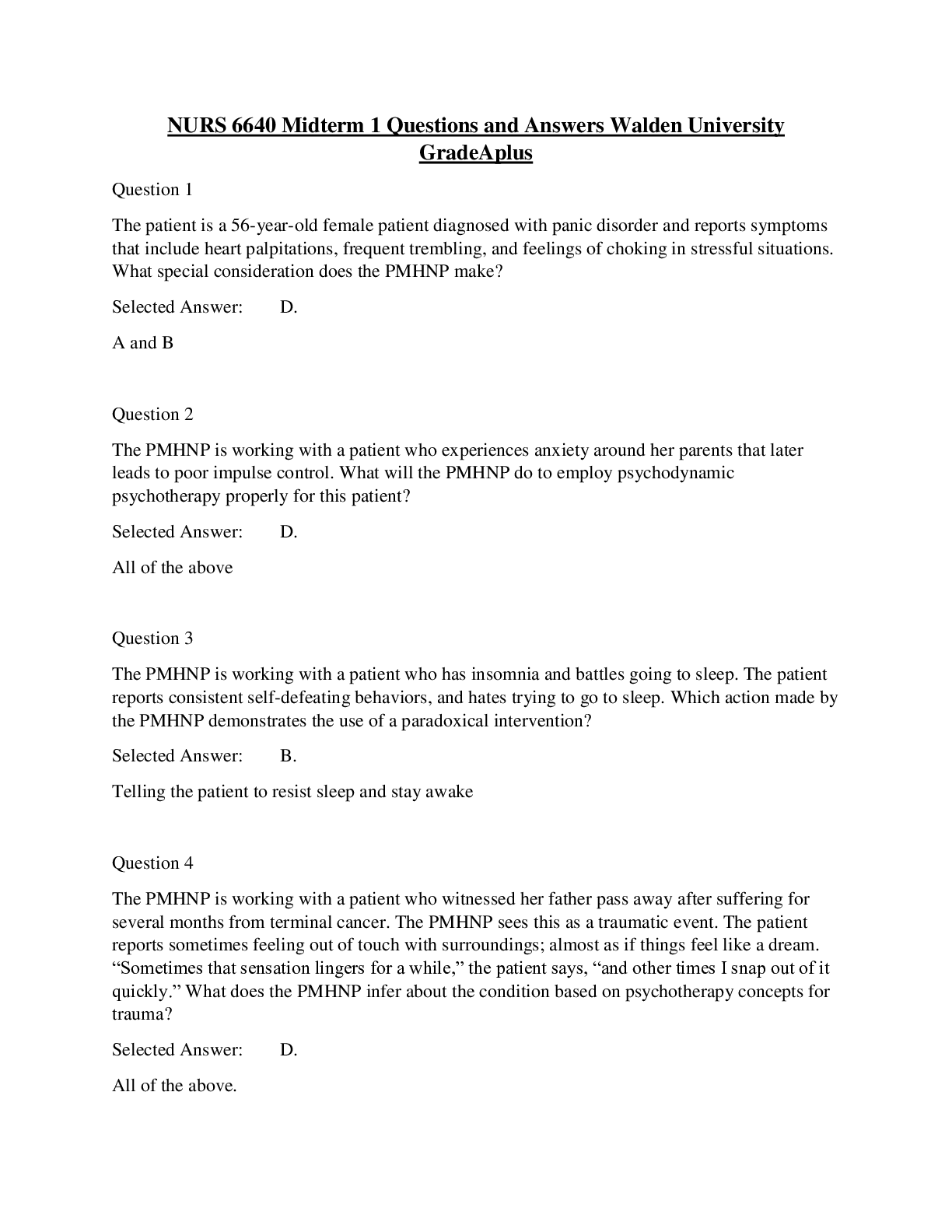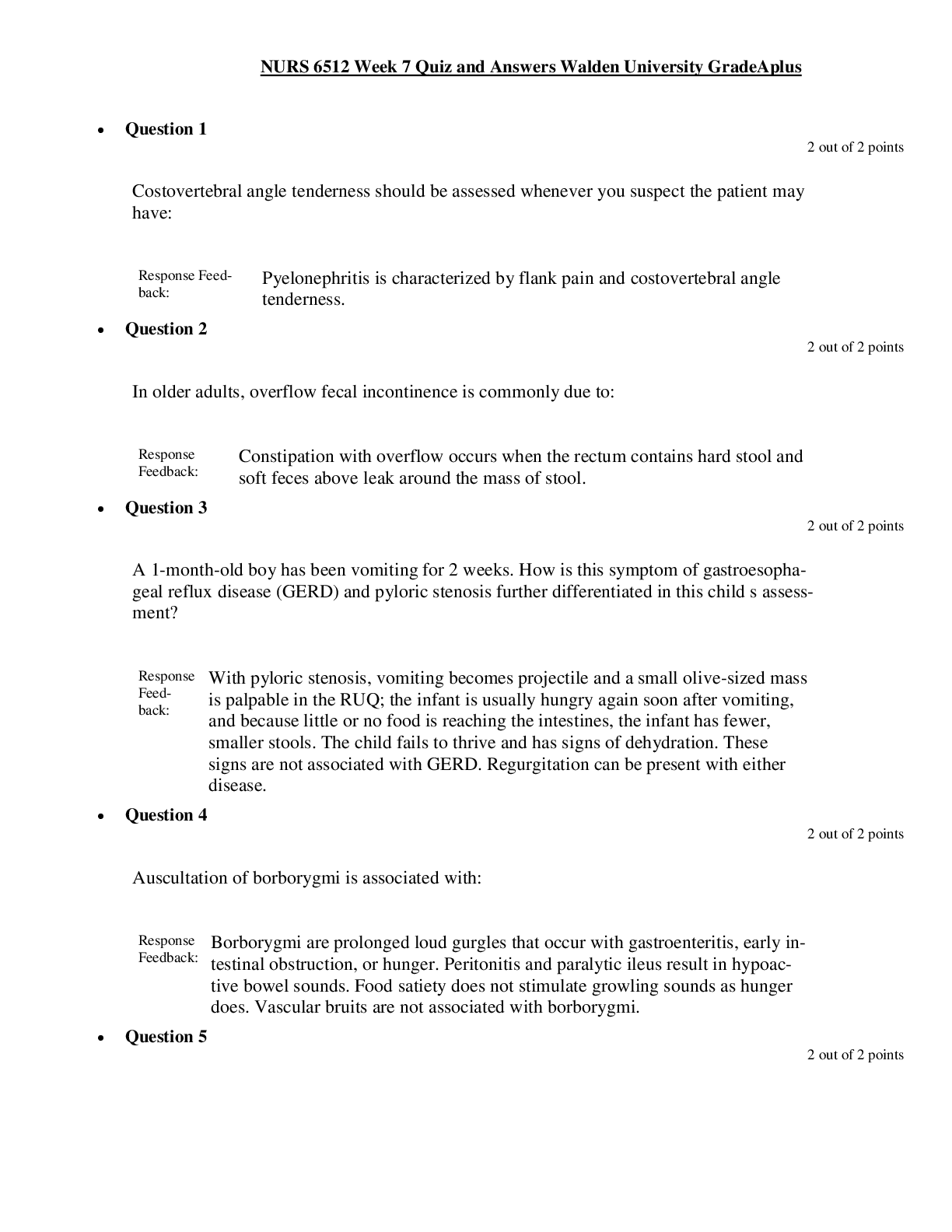*NURSING > EXAM > NURS 6501 Quiz 2 with Answers Walden University (Grade A+plus) | NURS6501 Quiz 2 with Answers (Grade (All)
NURS 6501 Quiz 2 with Answers Walden University (Grade A+plus) | NURS6501 Quiz 2 with Answers (Grade A+plus)
Document Content and Description Below
NURS 6501 Quiz 2 with Answers Walden University (Grade A+plus) • Question 1 1 out of 1 points A nurse recalls an example of an immune-complex-mediated disease is: • Quest... ion 2 1 out of 1 points A 10-year-old male is stung by a bee while playing in the yard. He begins itching and develops pain, swelling, redness, and respiratory difficulties. He is suffering from: • Question 3 1 out of 1 points When a patient presents at the emergency department for an allergic reaction, the nurse recognizes the most severe consequence of a type I hypersensitivity reaction is: • Question 4 1 out of 1 points A 5-month-old child is admitted to the hospital with recurring respiratory infections. A possible cause of this condition is: • Question 5 1 out of 1 points When histamine is released in the body, which of the following responses would the nurse expect? • Question 6 1 out of 1 points A 65-year-old female is diagnosed with metastatic breast cancer. She has developed muscle wasting. Which of the following substances would be produced in large quantities to eliminate the tumor cells and cause muscle wasting? • Question 7 1 out of 1 points When a patient asks the nurse what hypersensitivity is, how should the nurse respond? Hypersensitivity is best defined as: • Question 8 1 out of 1 points Which of the following hormones activates adrenergic receptors? • Question 9 1 out of 1 points While planning care, a nurse recalls seasonal allergic rhinitis is expressed through: • Question 10 1 out of 1 points While planning care for children with cancer, which information should the nurse remember? Most childhood cancers originate from the: • Question 11 1 out of 1 points When the maternal immune system becomes sensitized against antigens expressed by the fetus, what type of immune reaction occurs? • Question 12 1 out of 1 points A child fell off the swing and scraped the right knee. The injured area becomes painful. What else will the nurse observe upon assessment? • Question 13 1 out of 1 points A 10-year-old male presents to his primary care provider reporting wheezing and difficulty breathing. History reveals that both of the child’s parents suffer from allergies. Which of the following terms would be used to classify the child? • Question 14 1 out of 1 points A 30-year-old male is having difficulty breathing and has been spitting blood. He reports that he began experiencing this reaction after cleaning his pigeons’ cages. Testing reveals he is suffering from allergic alveolitis. Which of the following is he experiencing? • Question 15 1 out of 1 points A patient has a disease state that results from the secretion of toxins by bacteria. Which medical diagnosis will the nurse see documented on the chart? • Question 16 1 out of 1 points During inflammation, the liver is stimulated to release plasma proteins, collectively known as: • Question 17 1 out of 1 points A 3-year-old is making play cakes in a sandbox and is eating the play cakes. The sand was also being used by cats as a litter box and was contaminated with toxoplasmosis. Which of the following would most likely also be present? • Question 18 1 out of 1 points A 35-year-old male is diagnosed with lobar pneumonia (lung infection). Which of the following exudates would be present in highest concentration at the site of this advanced inflammatory response? • Question 19 1 out of 1 points A 45-year-old male presents with persistent, severe stomach pain. Testing reveals a peptic ulcer. Further laboratory tests reveal the presence of Helicobacter pylori. Which of the following is of concern for this patient? • Question 20 1 out of 1 points A 30-year-old male was diagnosed with HIV. Which of the following treatments would be most effective? • Question 21 1 out of 1 points A 20-year-old male shoots his hand with a nail gun while replacing roofing shingles. Which of the following cell types would be the first to aid in killing bacteria to prevent infection in his hand? • Question 22 1 out of 1 points A 35-year-old male is diagnosed with a hormone-secreting tumor of the adrenal medulla. He experiences elevated blood pressure, pupil dilation, “goose bumps,” and increased anxiety. Which of the following hormones is the predominant one released by the tumor? • Question 23 1 out of 1 points A 30-year-old female is diagnosed with cancer. Testing reveals that the cancer cells have spread to local lymph nodes. A nurse realizes this cancer would be documented as stage: • Question 24 1 out of 1 points An infant develops a fever secondary to a bacterial infection. Which of the following most likely triggered the fever? • Question 25 1 out of 1 points Which patient will develop active immunity? A patient who: • Question 26 1 out of 1 points A 5-year-old female takes a hike through the woods during a school field trip. Upon returning home, she hugs her father, and he later develops poison ivy. Which of the following immune reactions is he experiencing? • Question 27 1 out of 1 points The nurse would expect the occurrence of scabies to occur more commonly among children who: • Question 28 1 out of 1 points After studying about viruses, which information indicates the student has a good understanding of viruses? Viruses: • Question 29 1 out of 1 points A 46-year-old male presents with severe pain, redness, and tenderness in the right big toe. He was diagnosed with gouty arthritis. He is at risk for developing: • Question 30 1 out of 1 points After studying about fungi, which information indicates a correct understanding of fungi? Fungi causing deep or systemic infections: • Question 31 1 out of 1 points A 51-year-old male experienced severe acute gouty arthritis. Which of the following is the most common trigger for the symptoms? • Question 32 1 out of 1 points Tinea corporis (ringworm) is a _____ infection of the skin. • Question 33 1 out of 1 points In discoid lupus erythematosus, skin lesions may be accompanied by Raynaud phenomenon, which is manifested by: • Question 34 1 out of 1 points Rubella, rubeola, and roseola are common communicable diseases caused by _____ infection. • Question 35 1 out of 1 points A 5-year-old female was diagnosed with seropositive juvenile rheumatoid arthritis (RA). The treatment option for this disease is termed: • Question 36 1 out of 1 points Which cells are involved in initiating immune responses in the skin? • Question 37 1 out of 1 points When trying to distinguish between an infectious disease and noninfectious disease, what is the hallmark symptom for most infectious diseases? • Question 38 1 out of 1 points The nurse would correctly identify the medical term for ringworm as: • Question 39 1 out of 1 points A 4-month-old male is brought to his primary care provider for severe itching and skin lesions. He is diagnosed with atopic dermatitis. Which of the following would be elevated in this patient? • Question 40 1 out of 1 points The final stage of gout, characterized by crystalline deposits in cartilage, synovial membranes, and soft tissue, is called: [Show More]
Last updated: 2 years ago
Preview 1 out of 13 pages

Buy this document to get the full access instantly
Instant Download Access after purchase
Buy NowInstant download
We Accept:

Reviews( 0 )
$9.50
Can't find what you want? Try our AI powered Search
Document information
Connected school, study & course
About the document
Uploaded On
Jul 20, 2020
Number of pages
13
Written in
Additional information
This document has been written for:
Uploaded
Jul 20, 2020
Downloads
0
Views
96








 – University of the People.png)
